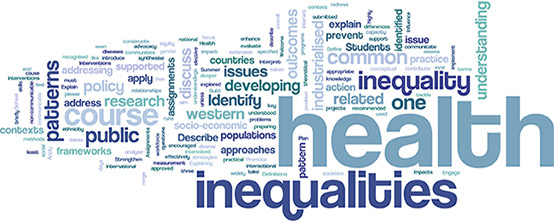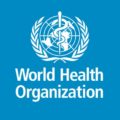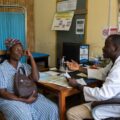What are health inequalities?
Health inequalities can be defined as the unjust and avoidable differences in people’s health across the population and between specific population groups. Some authors, particularly from North America, use ‘inequalities’ to denote differences between groups and ‘inequities’ to denote unjust differences between groups. The more commonly used term “inequality” has been adopted throughout this website to describe unjust differences. Health inequalities go against the principles of social justice because they are avoidable. They do not occur randomly or by chance. They are socially determined by circumstances largely beyond an individual’s control. These circumstances disadvantage people and limit their chance to live longer, healthier lives.
The existence of health inequalities in any country means that the right of everyone to the highest attainable standard of physical and mental health is not being enjoyed equally across the population. Health inequalities are observed in all societies. Although some inequalities may be considered unavoidable, resulting from sociodemographic characteristics such as age, gender, and genes, many of these health inequalities are associated with socioeconomic characteristics that are potentially amenable to policy interventions and could be considered as avoidable. In Europe, measuring and understanding these differences have been the major part of the literature on ‘health inequalities.’ In the US, these types of analyses are often referred to as ‘health disparities.
Public health research and action is built upon a shared understanding of ‘health’ and the related term ‘health inequalities’. Differences in how these terms are understood and defined and how this translates into measurement, analysis and interpretation have been discussed in the literature, but the assumptions, emphasis and values underlying the use of different approaches are less often explicit. Without these being clear, there is a risk of researchers, practitioners and policymakers talking at cross purposes. There is also the possibility that some definitions become used extensively without the underlying assumptions, emphasis and values being understood or accepted. SEE: Equity Vs Equality
What is meant by social gradient?
The poorest of the poor, around the world, have the worst health. Within countries, the evidence shows that in general the lower an individual’s socioeconomic position the worse their health. There is a social gradient in health that runs from top to bottom of the socioeconomic spectrum. This is a global phenomenon, seen in low, middle and high income countries. The social gradient in health means that health inequities affect everyone.For example, if you look at under-5 mortality rates by levels of household wealth you see that within counties the relation between socioeconomic level and health is graded. The poorest have the highest under-5 mortality rates, and people in the second highest quintile of household wealth have higher mortality in their offspring than those in the highest quintile. This is the social gradient in health.
What are the social ‘determinants’ of health?
The social determinants of health are the circumstances in which people are born, grow up, live, work and age, and the systems put in place to deal with illness. These circumstances are in turn shaped by a wider set of forces: economics, social policies, and politics.
What are the drivers of health inequities?
The global context affects how societies prosper through its impact on international relations and domestic norms and policies. These in turn shape the way society, both at national and local level, organizes its affairs, giving rise to forms of social position and hierarchy, whereby populations are organized according to income, education, occupation, gender, race/ethnicity and other factors. Where people are in the social hierarchy affects the conditions in which they grow, learn, live, work and age, their vulnerability to ill health and the consequences of ill health.
- The benefits of the economic growth that has taken place over the last 25 years are unequally distributed. In 1980 the richest countries, containing 10% of the world’s population, had gross national income 60 times that of the poorest countries, containing 10% of the world’s population. By 2005 this ratio had increased to 122.
- International flows of aid – grossly inadequate in themselves, and well below the levels promised – are dwarfed by the scale of many poor countries’ debt repayment obligations. The result is that, in many cases, there is a net financial outflow from poorer to richer countries – an alarming state of affairs.
- The trend over the last 15 years has been for the poorest quintile of the population in many countries to have a declining share in national consumption. In Kenya, for example, at current economic growth rates and with the present levels of income inequality, the median family in poverty would not cross the poverty line until 2030. Doubling the share of income growth enjoyed by Kenya’s poor would mean that reduction in poverty would have happened by 2013.
- Gender biases in power, resources, entitlements, norms and values, and the way in which organizations are structured and programmes are run damage the health of millions of girls and women. The position of women in society is also associated with child health and survival – of boys and girls.
- Health equity depends vitally on the empowerment of individuals to challenge and change the unfair and steeply graded distribution of social resources to which everyone has equal claims and rights. Inequity in power interacts across four main dimensions – political, economic, social, and cultural – together constituting a continuum along which groups are, to varying degrees, excluded or included.
How Inequities Should Be Addressed
The goal of addressing inequities is to achieve the opposite outcome: health equity. Ideally, everyone should have the opportunity to reach their full health potential regardless of their socioeconomic circumstances. Achieving health equity is an issue of human rights and international frameworks. The “right to health” is included in discourse of health partnerships and policies worldwide. Furthermore, inequities can act as rallying points for public demands for change, and resulting policies toward health equity often reduce political resistance. In this way, an inequity can act as a “social accountant,” a reliable way to monitor a city’s ability to meet its residents’ demands.Working to diminish health inequities improves cities in various ways, such as drawing in residents and investors, and decreasing crime. Furthermore, taking action to create equity among vulnerable and disadvantaged groups often incorporates “urban planning” projects that “[improve] transport systems, housing and green spaces . . . and better [prepare] cities for natural disasters.
The drawback of using averages to measure poverty in cities is that averages can “mask wide socioeconomic differentials. For instance, a city’s average household income would not reflect the pockets of extreme poverty or wealth in that area. Thus, health policies are inefficient when based on averages alone. Averages hide inequities that can be addressed by focusing policies on particular areas and groups of people. However, the creation of such policies requires extensive research into these specific communities.
Health Inequity Examples
Health inequities arise from inequalities within and between societies. Social and economic conditions and their effects on people’s lives determine their risk of illness and the actions taken to prevent them becoming ill or treat illness when it occurs.
Examples of health inequities between countries:
- the infant mortality rate (the risk of a baby dying between birth and one year of age) is 2 per 1000 live births in Iceland and over 120 per 1000 live births in Mozambique;
- the lifetime risk of maternal death during or shortly after pregnancy is only 1 in 17 400 in Sweden but it is 1 in 8 in Afghanistan.
Examples of health inequities within countries:
- in Bolivia, babies born to women with no education have infant mortality greater than 100 per 1000 live births, while the infant mortality rate of babies born to mothers with at least secondary education is under 40 per 1000;
- life expectancy at birth among indigenous Australians is substantially lower (59.4 for males and 64.8 for females) than that of non-indigenous Australians (76.6 and 82.0, respectively);
- life expectancy at birth for men in the Calton neighbourhood of Glasgow is 54 years, 28 years less than that of men in Lenzie, a few kilometres away;
- the prevalence of long-term disabilities among European men aged 80+ years is 58.8% among the lower educated versus 40.2% among the higher educated.
The Dilemma of the Urban Poor
Despite having the most severe health issues, the urban poor are often the most neglected by health officials primarily because many poor urban dwellers live in informal or illegal settlements or are homeless. Governments and NGOs also focus much of their attention on rural areas, leaving the urban poor to fend for themselves. Meanwhile, the urban poor are overshadowed by the urban rich and cannot afford the health care that wealthy individuals can access; though health care might be technically available to the poor, it is not realistically accessible. In this way, the urban poor “fall through the cracks.
Varying Neighborhoods Within Cities
Geography matters in terms of certain inequities. Some neighborhoods have access to fresh food from markets, while others must choose from fast food or street carts. While some areas have quality housing and clean spaces, others are polluted, crowded, and poorly constructed. Different areas have varying amounts of health and social services, and crime and disorder can cluster into the more vulnerable pockets of cities. Some of the greatest inequities between city neighborhoods are found in the world’s wealthiest cities. In poorer neighborhoods of New York City, for example, life expectancy is eight years shorter than in the city’s most affluent areas.
This is supported by studies demonstrating that the poorest neighborhoods (in economic terms) are those in which residents are the least likely to have access to health care, on top of the fact that they are already living in the most vulnerable environments. Disaggregated data in this case can help distinguish between different shortcomings of specific neighborhoods and can encourage policymakers to focus in on the exact needs of neighborhoods. This is not to say, however, that policies should be established based on geography alone. For example, not all urban poor live in slums or disadvantaged areas, and not all slum dwellers are poor. In fact, in Mumbai, a city with astronomical housing rates, “‘slumlike’ housing does not always connote extreme poverty or disadvantage.” Successful policies would have to combine considerations of economic status with other variables related to neighborhood setting.
Urban Slum Inequities
Slum dwellers experience some of the worse health conditions in the world. Slums are areas of poorly built, overcrowded tenements or shacks with unsanitary water and low-quality living conditions. Moreover, they are extremely unregulated. In India, almost half of the country’s slums are not officially recognized by municipalities, corporations, local bodies, or development authorities, and are therefore not included in policy or aid considerations. Residents of these informal areas tend to have the worst health outcomes. In Bangladesh, twice as many infant deaths occur in urban slums than in urban areas generally. Similarly, studies from Nairobi, Kenya show that people born in slums have unusually high mortality rates and, “children born in the slums to women who were pregnant at the time of migration have the highest risk of dying;” this indicates that “delivery in the slums has long-term health consequences for children.” In another study of slums in La Paz, Bolivia, people living in slums had worse health outcomes than people living elsewhere in the city. Compared to those not living in slums, women of La Paz slums were less aware of HIV/AIDS, other sexually transmitted diseases, and associated preventative measures, and they also had less access to (and consequently, less frequent use of) condoms. The children of the city’s slums suffer past infancy as well. Due to minimal access to health facilities and treatment, children in slums are less likely to be immunized, and therefore face higher mortality rates than their cohorts in non-slum areas. Slums continue to produce alarming health outcomes, with extreme deficiencies in nutrition, sanitation, safe water, and access to health services. SEE: Effects Of Poverty





